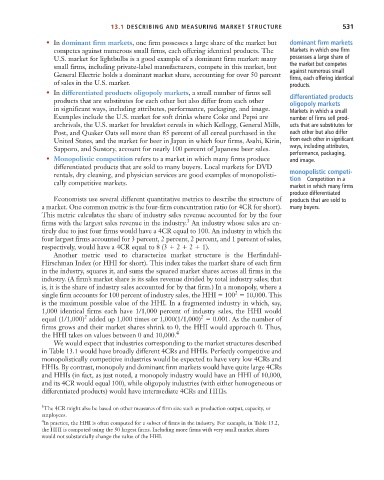Page 557 - Microeconomics, Fourth Edition
P. 557
c13marketstructureandcompetition.qxd 7/30/10 10:44 AM Page 531
13.1 DESCRIBING AND MEASURING MARKET STRUCTURE 531
• In dominant firm markets, one firm possesses a large share of the market but dominant firm markets
competes against numerous small firms, each offering identical products. The Markets in which one firm
U.S. market for lightbulbs is a good example of a dominant firm market: many possesses a large share of
small firms, including private-label manufacturers, compete in this market, but the market but competes
General Electric holds a dominant market share, accounting for over 50 percent against numerous small
firms, each offering identical
of sales in the U.S. market. products.
• In differentiated products oligopoly markets, a small number of firms sell differentiated products
products that are substitutes for each other but also differ from each other oligopoly markets
in significant ways, including attributes, performance, packaging, and image. Markets in which a small
Examples include the U.S. market for soft drinks where Coke and Pepsi are number of firms sell prod-
archrivals, the U.S. market for breakfast cereals in which Kellogg, General Mills, ucts that are substitutes for
Post, and Quaker Oats sell more than 85 percent of all cereal purchased in the each other but also differ
United States, and the market for beer in Japan in which four firms, Asahi, Kirin, from each other in significant
Sapporo, and Suntory, account for nearly 100 percent of Japanese beer sales. ways, including attributes,
performance, packaging,
• Monopolistic competition refers to a market in which many firms produce and image.
differentiated products that are sold to many buyers. Local markets for DVD
rentals, dry cleaning, and physician services are good examples of monopolisti- monopolistic competi-
tion
cally competitive markets. Competition in a
market in which many firms
produce differentiated
Economists use several different quantitative metrics to describe the structure of products that are sold to
a market. One common metric is the four-firm concentration ratio (or 4CR for short). many buyers.
This metric calculates the share of industry sales revenue accounted for by the four
3
firms with the largest sales revenue in the industry. An industry whose sales are en-
tirely due to just four firms would have a 4CR equal to 100. An industry in which the
four largest firms accounted for 3 percent, 2 percent, 2 percent, and 1 percent of sales,
respectively, would have a 4CR equal to 8 (3 2 2 1).
Another metric used to characterize market structure is the Herfindahl-
Hirschman Index (or HHI for short). This index takes the market share of each firm
in the industry, squares it, and sums the squared market shares across all firms in the
industry. (A firm’s market share is its sales revenue divided by total industry sales; that
is, it is the share of industry sales accounted for by that firm.) In a monopoly, where a
2
single firm accounts for 100 percent of industry sales, the HHI 100 10,000. This
is the maximum possible value of the HHI. In a fragmented industry in which, say,
1,000 identical firms each have 1/1,000 percent of industry sales, the HHI would
2
2
equal (1/1,000) added up 1,000 times or 1,000(1/1,000) 0.001. As the number of
firms grows and their market shares shrink to 0, the HHI would approach 0. Thus,
the HHI takes on values between 0 and 10,000. 4
We would expect that industries corresponding to the market structures described
in Table 13.1 would have broadly different 4CRs and HHIs. Perfectly competitive and
monopolistically competitive industries would be expected to have very low 4CRs and
HHIs. By contrast, monopoly and dominant firm markets would have quite large 4CRs
and HHIs (in fact, as just noted, a monopoly industry would have an HHI of 10,000,
and its 4CR would equal 100), while oligopoly industries (with either homogeneous or
differentiated products) would have intermediate 4CRs and HHIs.
3 The 4CR might also be based on other measures of firm size such as production output, capacity, or
employees.
4 In practice, the HHI is often computed for a subset of firms in the industry. For example, in Table 13.2,
the HHI is computed using the 50 largest firms. Including more firms with very small market shares
would not substantially change the value of the HHI.

